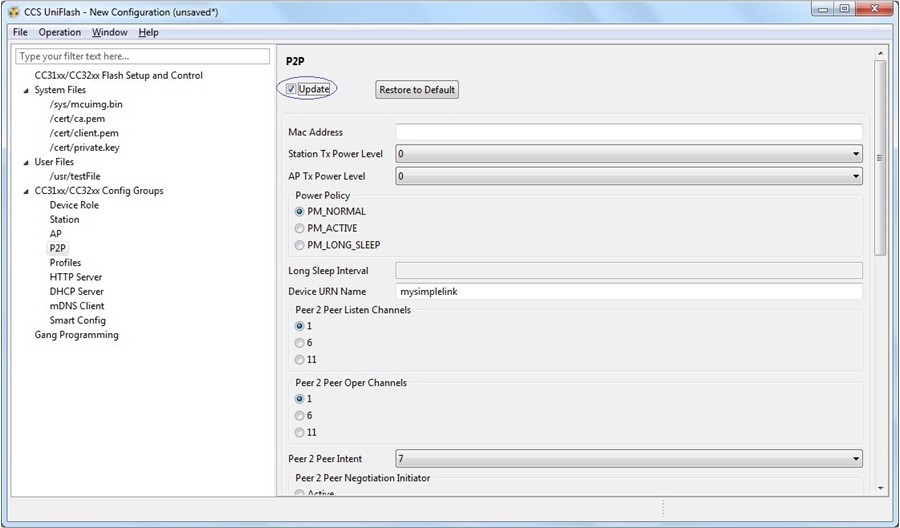SWRU558 June 2020 CC3100 , CC3100MOD , CC3200 , CC3200MOD
-
SimpleLink Wi-Fi CC3100, CC3200 UniFlash
- Trademarks
- 1 Introduction
- 2 Installation
- 3 Prerequisites
- 4 Uniflash Block Diagram
- 5 Session Support
- 6 Secured File System Support
- 7 GUI Interface
- 8 CC3200 Support
- 9 Command Line Support
- 10 Configuration File Support
- 11 Image Creation and Programming
- 12 Troubleshoot/Debugging
- 13 Limitations
- 14 References
- A UART Connection
10.3.4.5 Configuration
Figure 21 shows a screenshot of all the P2P parameters. Most parameters have default values in case the user decides to skip configuration. Mac Address parameter is the only one that does not have any default. Not setting this parameter is valid. If not set, the device burnt MAC address is used. In this screen, the following parameters are defined:
- MacAddress is not set. Default MAC address is the already burnt MAC address.
- Station Tx Power Level is set to default 0, (transmit at maximum power).
- AP Tx Power Level is set to default 0, (transmit at maximum power).
- Power Policy is set to default PM_NORMAL.=
- Long Sleep Interval is not relevant for PM_NORMAL
- Device URN Name is set to default mysimplelink
- Peer 2 Peer Listen Channels is set to default, channel # 1
- Peer 2 Peer Oper Channels is set to default, channel # 1
- Peer 2 Peer Intent is set to default 7
- Peer 2 Peer Negotiation Initiator is set to default Random
- Station Addressing Scheme is set to default Dynamic (retrieve network parameters from DHCP server).
- Station IP Address, Station Subnet Mask, Station Default Gateway and Station DNS Server are all not relevant since Station Addressing Scheme is not set to Static.
- Ap Addressing Scheme is set to default Dynamic (retrieve network parameters from DHCP server).
- Ap IP Address is set to default 192.168.1.1
- Ap Subnet Mask is set to default 255.255.255.0
- Ap Default Gateway is set to default 192.168.1.1.
- Ap DNS Server is set to default 192.168.1.1
- Station Network Application is set to default where HTTP Server and mDNS Client application are enabled.
- Ap Network Application is set to default where HTTP Server, DHCP Server and mDNS Client application are enabled.
 Figure 21. P2p Configuration
Figure 21. P2p Configuration